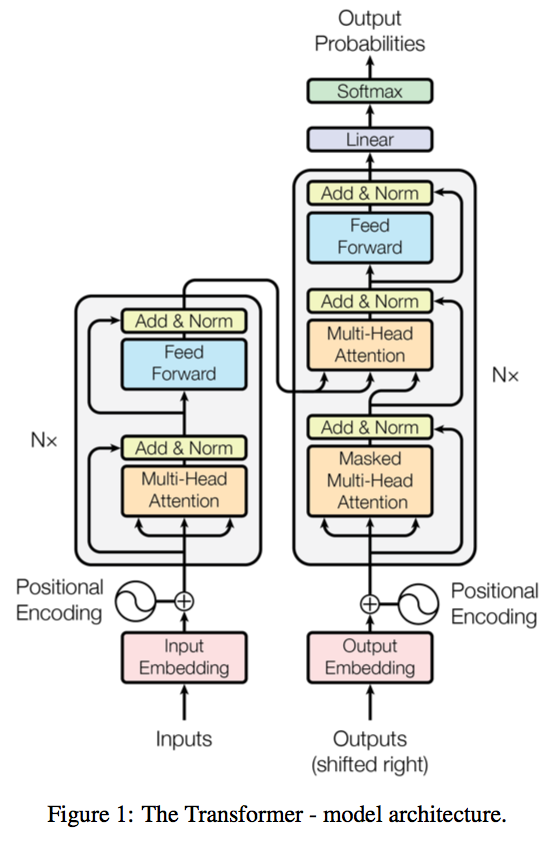"Attention is All you Need" 논문의 transformer를 구현하고 모델을 train해본다.
Transformer 네트워크 특징
- CNN이나 RNN을 사용하지 않고 Attention만을 이용한 Seq2Seq 모델
- Scaled-Dot Product attention 사용
- Scaled-Dot Product를 병렬로 수행하는 Multi-Head attention
- RNN에서 사용하는 BPTT(Back Propagation Through Time)이 없음
- Positional Encoding로 단어위치를 지정 (단어 input이 순서로 들어올 필요 없어 병렬 처리 가능)
Transformer 레이어 구성

- Input Embedding
- input을 vector로 만듦
- Positional Encoding
- 시간적 위치별로 고유의 코드를 더해줌
- 전체 sequence의 길이 중 상대적 위치에 따라 고유의 벡터를 생성하여 embedding된 벡터에 더함
- Milti-head Attention
- d_model 차원을 head개수만큼 linear projection한 후 scaled Dot-product를 head개수 만큼 수행
- scaled Dot-Product Attention
- Query, Key, Value 형식
- Softmax로 유사도를 0 ~ 1의 값으로 Normalize
- 유사도와 V를 MatMul해 Attention Value를 계산
- Add & Normalization
- 이전 값 skip connection
- Layer Normalization 수행
- Feed Forward
- Fully connected layer, Relu, Fully connected layer 구성
- Masked Multi-head Attention
- decoder에서 self attention 수행 시, 현재 값 이후에 attention이 수행되지 않게 mask를 씌움
- Mask를 이용하므로 illegal connection의 attention을 금지 (기존 attention과 다른 점)
논문 구현
# "Attention is All You Need" 논문의 Transformer 모델 구현
import random
import numpy as np
import tensorflow as tf
from konlpy.tag import Okt
from tensorflow.keras import Model, Sequential
from tensorflow.keras.layers import Dense, Lambda, Layer, LayerNormalization, Embedding
# Scaled Dot Product Attention
class ScaledDotProductAttention(Layer):
def __init__(self, d_emb, d_reduced, masked=False):
super().__init__()
self.q = Dense(d_reduced, input_shape=(-1, d_emb)) # linear projection
self.k = Dense(d_reduced, input_shape=(-1, d_emb)) # linear projection
self.v = Dense(d_reduced, input_shape=(-1, d_emb)) # linear projection
self.scaled = Lambda(lambda x: x/np.sqrt(d_reduced))
self.masked = masked
def call(self, x, training=None, masked=None): # x shape = (q, k, v)
q = self.q(x[0])
k = self.k(x[1])
v = self.v(x[2])
k_t = tf.transpose(k, perm=[0, 2, 1])
product = tf.matmul(q, k_t)
scaled = self.scaled(product)
if masked:
length = tf.shape(scaled)[-1]
mask = tf.fill((length, length), -np.inf)
mask = tf.linalg.band_part(mask, 0, -1) # upper triangle
mask = tf.linalg.set_diag(mask, tf.zeros(length))
scaled += mask
scaled = tf.nn.softmax(scaled, axis=-1)
return tf.matmul(scaled, v)
# Multi-head attention
class MultiHeadAttention(Layer):
def __init__(self, num_head, d_emb, d_reduced, masked=False):
super().__init__()
self.attention_list = list()
for _ in range(num_head):
self.attention_list.append(ScaledDotProductAttention(d_emb, d_reduced, masked))
self.linear = Dense(d_emb, input_shape=((-1, num_head * d_reduced)))
def call(self, x, training=None):
attention_list = [a(x) for a in self.attention_list]
concat = tf.concat(attention_list, axis=-1)
return self.linear(concat)
# Encoder
class Encoder(Layer):
def __init__(self, num_head, d_reduced):
super().__init__()
self.num_head = num_head
self.d_reduced = d_reduced
def build(self, input_shape):
self.multihead_attention = MultiHeadAttention(self.num_head, input_shape[-1], self.d_reduced)
self.layer_normalization1 = LayerNormalization(input_shape=input_shape)
self.dense1 = Dense(input_shape[-1] * 4, input_shape=input_shape, activation='relu')
self.dense2 = Dense(input_shape[-1])
self.layer_normalization2 = LayerNormalization(input_shape=input_shape)
super().build(input_shape)
def call(self, x, training=None, masked=None):
h = self.multihead_attention((x, x, x))
ln1 = self.layer_normalization1(x + h)
h = self.dense2(self.dense1(ln1))
return self.layer_normalization2(ln1 + h)
def compute_output_shape(self, input_shape):
return input_shape
# Decoder
class Decoder(Layer):
def __init__(self, num_head, d_reduced):
super().__init__()
self.num_head = num_head
self.d_reduced = d_reduced
def build(self, input_shape):
self.self_attention = MultiHeadAttention(self.num_head, input_shape[0][-1], self.d_reduced, masked=True)
self.layer_normalization1 = LayerNormalization(input_shape=input_shape)
self.multihead_attention = MultiHeadAttention(self.num_head, input_shape[0][-1], self.d_reduced)
self.layer_normalization2 = LayerNormalization(input_shape=input_shape)
self.dense1 = Dense(input_shape[0][-1] * 4, input_shape=input_shape[0], activation='relu')
self.dense2 = Dense(input_shape[0][-1])
self.layer_normalization3 = LayerNormalization(input_shape=input_shape)
def call(self, inputs, training=None, masked=None): #inputs (x, context)
x, context = inputs
h = self.self_attention((x, x, x))
ln1 = self.layer_normalization1(x + h)
h = self.multihead_attention((ln1, context, context))
ln2 = self.layer_normalization2(ln1 + h)
h = self.dense2(self.dense1(ln2))
return self.layer_normalization3(ln2 + h)
def compute_output_shape(self, input_shape):
return input_shape
# Positional Encoding
class PositionalEncoding(Layer): # Referred from https://github.com/LastRemote/Transformer-TF2.0
def __init__(self, max_len, d_emb):
super().__init__()
self.sinusoidal_encoding = np.array([self.get_positional_angle(pos, d_emb) for pos in range(max_len)], dtype=np.float32)
self.sinusoidal_encoding[:, 0::2] = np.sin(self.sinusoidal_encoding[:, 0::2])
self.sinusoidal_encoding[:, 1::2] = np.cos(self.sinusoidal_encoding[:, 1::2])
self.sinusoidal_encoding = tf.cast(self.sinusoidal_encoding, dtype=tf.float32)
def call(self, x, training=None, mask=None):
return x + self.sinusoidal_encoding[:tf.shape(x)[1]]
def compute_output_shape(self, input_shape):
return input_shape
def get_angle(self, pos, dim, d_emb):
return pos / np.power(10000, 2 * (dim // 2) / d_emb)
def get_positional_angle(self, pos, d_emb):
return [self.get_angle(pos, dim, d_emb) for dim in range(d_emb)]
# Transformer
class Transformer(Model):
def __init__(self, src_vocab, dst_vocab, max_len, d_emb, d_reduced, n_enc_layer, n_dec_layer, num_head):
super().__init__()
self.enc_emb = Embedding(src_vocab, d_emb)
self.dec_emb = Embedding(dst_vocab, d_emb)
self.pos_enc = PositionalEncoding(max_len, d_emb)
self.encoder = [Encoder(num_head, d_emb) for _ in range(n_enc_layer)]
self.decoder = [Decoder(num_head, d_emb) for _ in range(n_dec_layer)]
self.dense = Dense(dst_vocab, input_shape=(-1, d_emb))
def call(self, inputs, trainig=None, masked=None): # inputs = (src_sentence, shifted src_sentence)
src_sentence, dst_sentence = inputs
h_enc = self.pos_enc(self.enc_emb(src_sentence))
for enc in self.encoder:
h_enc = enc(h_enc)
h_dec = self.pos_enc(self.dec_emb(dst_sentence))
for dec in self.decoder:
h_dec = dec([h_dec, h_enc])
return tf.nn.softmax(self.dense(h_dec))
# 데이터 준비
NUM_WORDS = 2000
EPOCHS = 200
dataset_file = 'chatbot_data.csv'
okt = Okt()
with open(dataset_file, 'r') as file:
lines = file.readlines()
seq = [' '.join(okt.morphs(line)) for line in lines]
questions = seq[::2]
answers = ['\t' + lines for lines in seq[1::2]]
num_sample = len(questions)
perm = list(range(num_sample))
random.seed(0)
random.shuffle(perm)
train_q = list()
train_a = list()
test_q = list()
test_a = list()
for idx, qna in enumerate(zip(questions, answers)):
q, a = qna
if perm[idx] > num_sample // 5:
train_q.append(q)
train_a.append(a)
else:
test_q.append(q)
test_a.append(a)
tokenizer = tf.keras.preprocessing.text.Tokenizer(num_words=NUM_WORDS, filters='!#%&()*+,-./:;<=>@[\\]^_`{|}?')
tokenizer.fit_on_texts(train_q + train_a)
train_q_seq = tokenizer.texts_to_sequences(train_q)
train_a_seq = tokenizer.texts_to_sequences(train_a)
test_q_seq = tokenizer.texts_to_sequences(test_q)
test_a_seq = tokenizer.texts_to_sequences(test_a)
x_train = tf.keras.preprocessing.sequence.pad_sequences(train_q_seq, value=0, padding='pre', maxlen=64)
y_train = tf.keras.preprocessing.sequence.pad_sequences(train_a_seq, value=0, padding='post', maxlen=65)
y_train_shifted = np.concatenate([np.zeros((y_train.shape[0], 1)), y_train[:, 1:]], axis=1)
x_test = tf.keras.preprocessing.sequence.pad_sequences(test_a_seq, value=0, padding='pre', maxlen=64)
y_test = tf.keras.preprocessing.sequence.pad_sequences(test_a_seq, value=0, padding='post', maxlen=65)
# Training
transformer = Transformer(NUM_WORDS, NUM_WORDS, 128, 16, 16, 2, 2, 4)
transformer.compile(optimizer='adam',loss='sparse_categorical_crossentropy', metrics=['accuracy'])
transformer.fit([x_train, y_train_shifted], y_train, batch_size=5, epochs=EPOCHS)